Going Local
Going ‘local’ is about more than just growing food within the confines of the Mother City to meet our need for fresh whole foods. It is about looking at different ways to shorten the value chain, and to localise how we ship, store, process, pack, sell, select, eat and commune around food, and what we do with the leftovers.

We recognise that we can’t localise the entire food system. For instance, Cape Town needs several times more land than it has, in order to provide the city with all its food, according to the University of Cape Town’s Dr Gareth Haysom. And we don’t have the right climate to grow the full diversity of food we eat. But we can look at ways to reduce the huge distances that urban, industrial life has put between our food and us, be it the physical distance between farm and fork, or the attitudes we have towards food.
Positive Spinoffs

Where the food system can be localised, it can have the following positive spinoffs:
Preserve the nutritional content in fresh produce, because of the shorter distances and time between harvest and consumption.
It’s easier to return to whole foods. The long distances between farm and fork mean retailers often choose foods with a longer shelf life that can withstand the extensive handling that happens along a long value chain. This pushes us towards more refined and grain-based foods, and away from fresh produce that perishes quickly and damages easily. Think of the difference between mealie meal and spinach in terms of shelf life, it’s ability to withstand handling, and it’s nutritional value.
It reduces the carbon and water footprint of the food, which are important aspects of the sustainability of our food production system.
It decentralises the food system, putting it back in the hands of small businesses and informal traders (farmers, street traders, independent retailers, small processors, etc), instead of being controlled by a few industrial-scale operations in the agribusiness, food processing, and retail sectors. This allows alternative and parallel value chains to thrive, it creates local jobs across the value chain and keeps money within the community.
However, localising the food system does not mean merely growing more food within the city in order to keep Capetonians well fed and properly nourished. Producing more does not guarantee everyone will have fair and equal access to that food, or that they will even choose that food if they do have access to it. Urban agriculture is only a part of the solution to getting the right food onto our plates.
We need to understand the other drivers behind why people can’t access or won’t choose wholesome, nutritious food: poverty; market forces; the city layout and how that impacts on where people live and work in relation to food hubs; transport, and people’s time and money; and also cultural grooming and the ‘nutritional transition’ towards branded highly processed, high-sugar foods.
We already know the value of growing some of our food within the borders of our city. What this report hopes to achieve is to help us rethink the notion of food, community and the entire food system.
Our aim is to find ways to ensure that all Capetonians – rich and poor – have a fair chance of getting wholesome, affordable, nutritious food onto their plates every day.
Food Security

We, as Capetonians, are ‘food secure’ if we have access to healthy, safe, affordable, culturally appropriate food every day. Whether or not we go hungry or get nourishing food is not only about whether we grow enough food or have enough circulating in the city, it’s about who has access to that food, every day, and what choices we make with that food.
The notion of food sovereignty takes this a step further, asserting the right of people to be in charge of their own food systems.